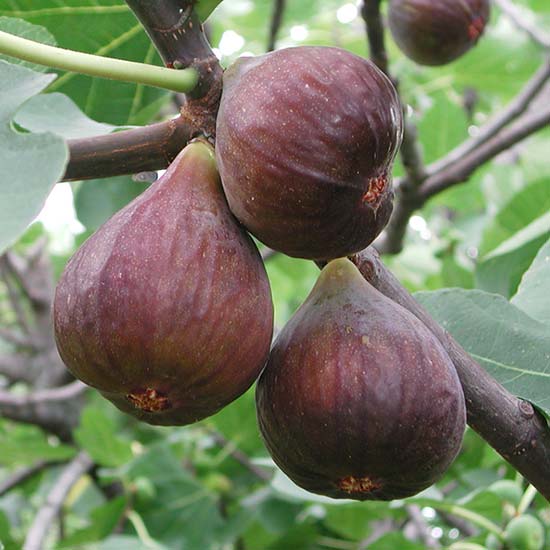The early Autumn sees the end of the ripening figs in the UK. The shortening days and waning heat prevent the figs from moving to that marvelously soft and often high coloured ripeness that signals a perfect eating experience.
Fig trees do of course continue to carry the unripe figletts through the Autumn and into Winter. With many varieties these figletts will remain on the tree right the way through to the spring of the next year. However, it is almost inconceivable that these will start to swell and transform themselves into edible figs for late spring and early summer. For this reason, it is sensible to remove them from the tree in Autumn when leaf drop starts to occur.
Figs rarely if ever throw shoots along the length of last summer’s growth without some encouragement. In those areas, which rarely have excessively cold winters then this encouragement in the form of pruning last year’s growths can be carried out in Autumn (after leaf fall). In the colder areas, then it is safer to wait until the early Spring, after the risk of late frost. Pruning in this way stops the lengths of bare and unsightly branches occurring.
Pruning back the previous summers growths by about 50% will encourage two or three dormant buds which surround the old leaf sites to shoot. As these buds grow in the spring, then they should quickly start to show figletts. The more horizontal the branches and shoots can be kept, then the more likely the figletts are to size and ripen.
At the same time as cutting back last year’s growth, then special attention should be given to very strong growing branches which have a greater diameter than half that of the main stem. These very strong branches will grow very upright and are unlikely to grow figs that ripen during our summers. The best practice is to remove these very strong branches at their source.
Figs can be successfully grown in pots for several years, but pots should not be considered their permanent home. Seven years is about the maximum that should be hoped for. It is important also to remember that figs, along with many fruits need a large volume of soil to crop well in pots, so a final pot size of at least 30 litres and hopefully greater, should be aimed at. Very good drainage should be laid in the base of the containers and the pot must be raised up from the ground to ensure that the drainage holes are not blocked.
Multi-purpose growing compost are not suitable for figs and a soil-based compost with added grit and stone should be used. Regular feeding in pots during the growing season is essential with both soil and leaf applied compounds (foliar feed) being used.
Good water management of the soil is also essential and remember that to ere on the side of dryness is preferable than to saturate the soil. Having adequate but not excess water is the aim and many things must be considered:
- The position of the pot in relation to the heat of the sun.
- How strong have been the winds of recent days.
- How much leaf is the plant carrying.
- How much natural rain has fallen since last applying water.
Unless the temperatures have been excessively high it is safer to water once or twice a week rather than to water daily.
The fig is not a tree to plant and forget and they do require work and attention. However, the results of your labours are well worth the effort when you taste a perfectly ripe fruit picked straight from the tree after the warmth of the sun has been on the fruits all of the day.
Recommended varieties:
Brown Turkey – The best known fig in the UK and for very good reason. Ripening in the early to late Autumn this very heavy cropping variety is cold hardy even in the most exposed areas of the UK. The tree is noted to live for an exceptional length of time.
The Chelsea Fig – The secret of West London! Found growing wild on the banks of the River Thames near Chelsea Bridge by Will Sibley in 1993, this tree which crops so abundantly has been a secret of the residents of Chelsea for very many years. Although the fruits are quite small, this delicious fig makes up in quantity rather than size. Often held in bunches of three or four, the figs ripen to a golden tan colour and have a superb flavour and texture. The perfect gift for every Chelsea Football Club fan!
Madeleine de deux Saisons – A heavy cropping and deliciously sweet fig to eat. It has a very fine and smooth texture. The tree is exceptionally cold hardy and has been in cultivation since the time of King Louis X1V at Versailles. It has the synonym of Angélique and Early Lemon.
Will Sibley
13th September 2022
Will is a leading nurseryman and master grafter who has introduced many well known varieties of fruit to the UK. He is a a former Master of the Worshipful Company of Fruiterers and has also previously served as the chairman of the East Malling Trust.

